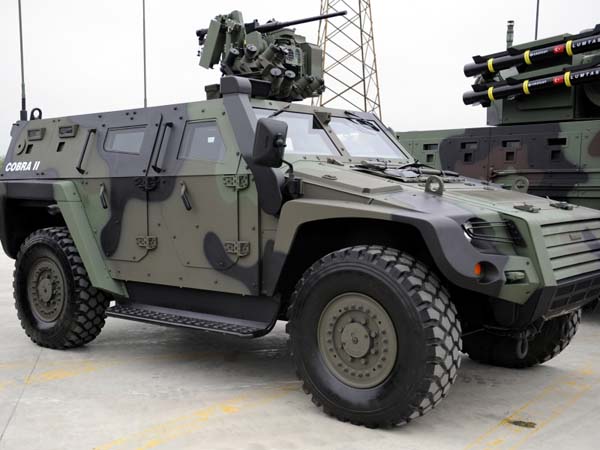F-22Raptor
ELITE MEMBER

- Joined
- Jun 19, 2014
- Messages
- 16,971
- Reaction score
- 3
- Country
- Location

The Army awarded Oshkosh Defense a $6.75 billion contract for the Joint Light Tactical Vehicle (JLTV) today, covering 17,000 vehicles for the Army and for the Marine Corps.
AM General, Lockheed Martin and Oshkosh have been competing for the contract for the largest recent ground vehicle program, which replaces the aging Humvee. The three were picked in 2012 to build prototypes for testing, and in February they submitted their bids for the low-rate initial production contract.
“Procurement of 5,500 USMC vehicles are front-loaded into the JLTV production plan. Initial USMC operating capability is expected in Fiscal Year 2018 with fielding to Marine Corps complete in FY2022,” read a statement from the U.S. Army.
“The Army anticipates having its first unit equipped in FY2018. Army procurement will last until approximately 2040 and replace a significant portion of the Army’s legacy light tactical vehicle fleet with 49,099 new vehicles.”
The Army anticipates having its first unit equipped in FY2018. Army procurement will last until approximately 2040 and replace a significant portion of the Army’s legacy light tactical vehicle fleet with 49,099 new vehicles.
During three years of low-rate initial production, Oshkosh Defense will build approximately 17,000 JLTVs for the Army and Marine Corps before moving into five years of full-rate production, according to a March Congressional Research Service report on the program.
The first Army unit would be equipped with JLTVs in Fiscal Year 2018, and Army JLTV acquisition would last until 2040. The Marine Corps would have a much more compact buy, lasting only through FY 2022.
In FY 2016, the Marines intend to spend $79.4 million for 109 vehicles, and the Army $308 million for 450 vehicles – though those figures have not yet been finalized, as Congress continues to work on the defense budget for the fiscal year that begins Oct. 1.
The vehicles are larger than the Humvees they replace and much more survivable.
“As planned, JLTVs would be more mechanically reliable, maintainable (with on-board diagnostics), all-terrain mobile, and equipped to link into current and future tactical data nets. Survivability and strategic and operational transportability by ship and aircraft are also key JLTV design requirements,” the CRS report noted.
The vehicles come in two variants – a four-passenger combat tactical vehicle and a two-passenger combat support vehicle – and must weigh 15,639 pounds or less so that Marine Corps CH-53K and Army CH-47F helicopters can carry them, according to the report.
As the Marine Corps and Army worked together on the program, both needed a survivable platform, but the Marines had to consider weight and size restrictions so JLTVs could fit onto amphibious ships and surface connectors.
A 2014 Marine Corps presentation noted the difficulties of keeping up with increasingly heavy heavy equipment – the San Antonio-class (LPD-17) amphibious transport dock was designed to carry a fleet of M1123 Humvees weighing 5,850 pounds each, currently carries M1165A1 Humvees at 9,870 pounds each, and will soon carry the JLTV at more than 15,000 pounds per truck. With a contractor finally selected, more detailed work can take place to understand how the new JLTV design fits in with Marine Corps shipping and aviation and surface connectors.
The following is the complete Aug. 25, 2015 announcement from the U.S. Army on the JLTV award.
WASHINGTON (August 25, 2015) — Today, the U.S. Army awarded the Oshkosh Corporation located in Oshkosh, WI, a firm fixed price production contract for the Joint Light Tactical Vehicle (JLTV) program. The total contract value, including all options is $6,749,799,374.25. JLTV is an Army-led, joint acquisition program with the U.S. Marine Corps (USMC) intended to close an existing gap in each Services’ light tactical vehicle fleet.
“I am tremendously proud of the JLTV program team,” said Heidi Shyu, the Assistant Secretary of the Army (Acquisition, Logistics and Technology). “Working with industry, they are delivering major improvements in protected mobility for Soldiers and have succeeded in executing a program that remains on-budget and on-schedule.”
The Army selected the Oshkosh Corporation from three competing firms participating in the program’s engineering and manufacturing development phase, which began in 2012 and concluded earlier this year. Each vendor delivered 22 prototype vehicles as part of JLTV development, which were utilized as part of an intensive, 14-month competitive test.
“With America’s Soldiers and Marines in mind, the program team successfully met both Services’ requirements for affordable, achievable capability advancements that will make a true difference,” said Sean Stackley, the Assistant Secretary of the Navy (Research, Development, and Acquisition). “Today’s award brings us a step closer to delivering a flexible vehicle that balances the payload, performance, and protection critical in the operating environments of today and tomorrow.”
Low Rate Initial Production is slated to begin in the first quarter of fiscal year (FY) 2016. The Army and Marine Corps will procure approximately 17,000 vehicles under this initial contract, with a decision on full rate production by the Department expected in FY18. Procurement of 5,500 USMC vehicles are front-loaded into the JLTV production plan. Initial USMC operating capability is expected in Fiscal Year 2018 with fielding to Marine Corps complete in FY2022.
The Army anticipates having its first unit equipped in FY2018. Army procurement will last until approximately 2040 and replace a significant portion of the Army’s legacy light tactical vehicle fleet with 49,099 new vehicles.
JLTV manufacturing will be performed in Oshkosh, WI with deliveries beginning 10 months after award. A full rate production decision is expected in FY2018. JLTV remains a priority modernization effort for the Army and USMC.
Army, Marine Corps Pick Oshkosh to Build Humvee Follow-on in $6.75B Contract Award - USNI News











